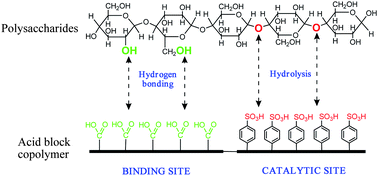
In an effort to make the process more commercially viable, scientists at Qingdao Institute of Bioenergy and Bioprocess Technology, China, have designed and synthesized efficient catalysts for the hydrolysis of starch and cellulose based on copolymers of poly(acrylic acid) and poly(styrene sulfonic acid). The random copolymer PAA-r-PSSH gave the highest glucose yield among the prepared catalysts which the team attribute to the synergic effect of the SO3H and COOH groups in the polymer chain.
Read the article for free until 30th December (free registration required):
Sulfonated copolymers with SO3H and COOH groups for the hydrolysis of polysaccharides
Xiutao Li, Yijun Jiang, Li Shuai, Lili Wang, Lingqian Meng and Xindong Mu
J. Mater. Chem., 2012, Advance Article
DOI: 10.1039/C1JM12954F
To keep up-to-date with all the latest research, sign up for the journal’s e-alerts or RSS feeds or follow Journal of Materials Chemistry on Twitter.
– Russell Johnson, Development Editor, Journal of Materials Chemistry
Xiutao Li, Yijun Jiang, Li Shuai, Lili Wang, Lingqian Meng and Xindong Mu
J. Mater. Chem., 2012, Advance Article
DOI: 10.1039/C1JM12954F










